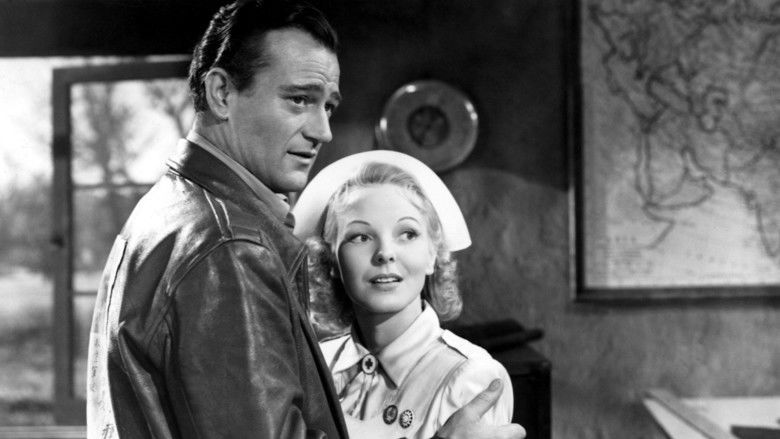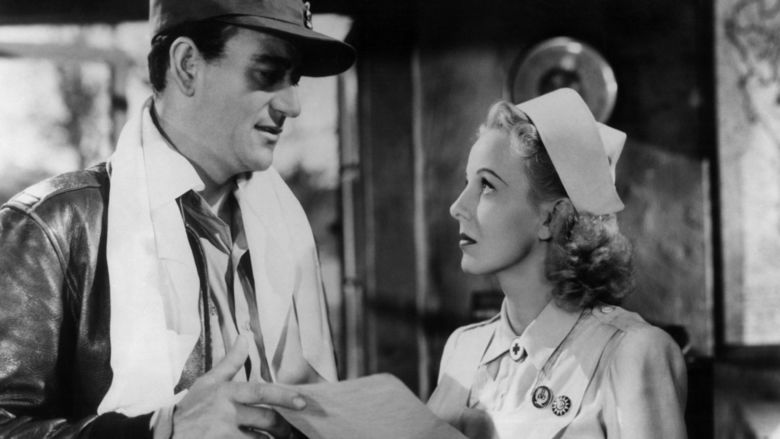Flying Tigers (film)
6.6 /10 1 Votes
63% Rotten Tomatoes Genre Action, Drama, War Duration Country United States | 6.8/10 IMDb Language English | |||||||||||||||||||||||||||||||||
 | ||||||||||||||||||||||||||||||||||
Writer Kenneth Gamet , Barry Trivers Release date October 8, 1942 (1942-10-08) Genres War film, Action Film, Drama, Black-and-white, Epic film, Action/Adventure Cast (Jim Gordon), (Woodrow 'Woody' Jason), (Brooke Elliott), (Hap Smith), ('Alabama' Smith), (Verna Bales) Similar movies Saving Private Ryan , Fury , When Trumpets Fade , Hell Is for Heroes , None But the Brave , The Thin Red Line Tagline Strong Brave Men Flying in the Face of Death that We may Live ... | ||||||||||||||||||||||||||||||||||
Favorite john wayne scene from flying tigers
Flying Tigers (a.k.a. Yank Over Singapore and Yanks Over the Burma Road) is a 1942 black-and-white war film from Republic Pictures, produced by Edmund Grainger, directed by David Miller, and starring John Wayne, John Carroll, and Anna Lee.
Contents
- Favorite john wayne scene from flying tigers
- Flying tigers theatrical movie trailer 1942
- Plot
- Cast
- Production
- Historical accuracy
- Reception
- Proposed sequel
- Oscar nominations
- References

Flying Tigers dramatizes the exploits of the American Volunteer Group (AVG), Americans already fighting the enemy in China prior to the U. S. entry into World War II. It is unabashedly a wartime propaganda film that was well received by a 1940s audience looking for a patriotic "flagwaver".

Flying tigers theatrical movie trailer 1942
Plot

Jim Gordon (John Wayne in his first war film) leads the Flying Tigers, a squadron of freelance American pilots who fly Curtiss P-40B fighters against Japanese aircraft in the skies over China. The pilots are a mixed bunch, motivated by money (they receive a bounty for each aircraft shot down), or just the thrill of aerial combat.

One day, old friend and former airline pilot Woody Jason (John Carroll) signs up under Jim's command. An arrogant, hot-shot aviator, he starts causing trouble immediately. When the Japanese raid the Flying Tigers' airbase, the enthusiastic new arrival goes after them, taking up a P-40 fighter without permission, not realizing until too late that it has no ammunition. As a result, Woody is shot down. He is unharmed after his fighter crash lands, but the precious P-40 fighter is a total wreck. As time goes on, Woody shows that he has little use for teamwork, alienating and endangering the other pilots. He abandons his wingman, Blackie Bales (Edmund MacDonald), in order to shoot down a Japanese aircraft. As a result, Blackie comes under fire from another and must bail out of his burning P-40. While hanging suspended in his parachute, he is strafed to death by the Japanese pilot.
Woody starts romancing nurse Brooke Elliott (Anna Lee), who is considered by all the Tiger pilots to be Jim's girlfriend. One night, they go on a date. When he is late getting back for a night patrol, Jim's right-hand man, "Hap" Smith (Paul Kelly), secretly takes his place, despite having just been grounded by Jim because his vision had deteriorated, notably at night. In the resulting dogfight Hap is unable to judge distances accurately and winds up dying in a collision with a Japanese aircraft he is pursuing. This proves to be the final straw. While sitting at his office desk, Jim fires Woody, explaining that "It's out of my hands now. None of these men will ever fly with you again. And they have to fly". The date showing on Jim's calendar is Sunday, December 7, 1941, the day of the Japanese attack on Pearl Harbor, bringing America into World War II.
A day later, Jim receives notice that a vital bridge must be destroyed. The target is so heavily defended, however, that the only way there might be a chance of succeeding is to fly in very low with a single unescorted bomber to attack the bridge; the mission appears likely to be a one-way suicide mission. Jim volunteers to fly the bomber, but Woody invites himself along at the last second, much to Jim's irritation. They proceed to attack the bridge too late to keep a crucial enemy supply train from crossing. Their aircraft is hit by flak and catches fire. Jim bails out with an unexpected push from Woody, expecting Woody to follow. Woody, however, has concealed the fact that he is bleeding, having been hit by shrapnel from a flak burst. He then takes the bomber's controls and heroically crashes into the train, destroying it at the cost of his own life. Back at the Tigers' base, Woody has left a goodbye letter which Jim and Brooke read; in that letter he has asked for his lucky scarf to be given to the next pilot who thinks aerial combat will be "an easy racket". Jim hands the scarf to his youthful new wingman, telling him to "Take good care of it ... it belonged to a pretty good flyer".
Cast
As appearing in Flying Tigers, (main roles and screen credits identified):
Production
Former Flying Tigers Lawrence Moore (who was a clerk) and Kenneth Sanger (who worked in communications) served as technical advisers on Flying Tigers. Both had left the American Volunteer Group (AVG) in February 1942. None of the real pilots are mentioned by name in the film, which went into production while the original AVG was still in operation.
While archival combat footage was used in some of the scenes, miniatures were used to portray the early model Curtiss P-40B/C Tomahawks that the Tigers flew on screen. For all ground shots, full-size P-40 mock-ups were used that did no more than taxi. They were propelled by V-8 automobile engines, and the elevators and ailerons were missing from their wings and rear horizontal stabilizers. John Wayne's character arrives at the Tigers' airbase on the one-off Capelis XC-12, a failed 1933 twin-engine transport aircraft that found new life at RKO as a non-flying movie prop. The aircraft was also used in Five Came Back and other films.
The American and Japanese aerial combat footage in Flying Tigers were actually miniatures being pulled along on wires off-screen, created by Republic's special effect experts Howard and Theodore Lydecker. This also included the miniature train and bridge sequence in the film's climax, as well as the miniature of the Capelis air transport seen flying through canyons and eventually crashing into the train. Flying Tigers's special effects were nominated for an Academy Award, but many people voting did not realize the aircraft were miniatures running on wires, thereby passing the film by for the Oscar.
In 1942, due to wartime priorities that prohibited the use of U. S. military aircraft for Hollywood productions, Republic Studios approached Curtiss-Wright in Buffalo to recreate the aerial battle sequences required for Flying Tigers. A number of P-40F fighter aircraft waiting for delivery to the U. S. Army Air Forces were repainted in American Volunteer Group (AVG) markings, and with the aid of Curtiss test pilots, flew in the film. Chief Production Test Pilot Herbert O. Fisher's screen role was in subbing for John Wayne.
Plot and character elements were lifted wholesale from the 1939 film Only Angels Have Wings without any acknowledgement, leading some to suggest that Angels director Howard Hawks should sue.
Flying Tigers was originally going to be called Yanks Over Burma Road but was changed because of MGM's film A Yank on the Burma Road.
Republic Pictures provided a larger budget than normal for the film, borrowing John Carroll and David Miller from MGM. In exchange MGM got an option on John Wayne's services.
Filming began in April 1942.
Historical accuracy
Flying Tigers only loosely represents the story of the real American Volunteer Group (AVG). Unlike the film characters, all AVG pilots were recruited from active or reserve U. S. military forces, were in Asia with the approval of the U. S. government, and did not see combat before the Japanese attack on Pearl Harbor. The first AVG combat mission was December 20, 1941, nearly two weeks after the Pearl Harbor attack. (AVG commander Chennault, however, had seen combat during his prior Chinese service.)
John Wayne's character is nicknamed "Pappy", a common nickname for older military commanders. This was also the nickname of Gregory Boyington, a U. S. Marine Corps pilot who flew with the AVG until early 1942. Boyington returned to the U. S. to rejoin the Marines, becoming an ace while commanding VMF-214 (the "Black Sheep", which inspired the TV series Baa Baa Black Sheep). Wayne's character, however, was not based on Boyington, who was not commander of the AVG, and not known as "Pappy" until he commanded VMF-214 in late 1943.
The aviation goggles worn by John Wayne on screen and seen on RKO promotional posters were actually a set of repurposed tank crew goggles.
Another ahistorical detail is in the scene where Jim Gordon discharges Woody Jason. Gordon stresses to Jason that the other pilots "have to fly". The camera shows the date on the calendar: December 7, 1941. The unspoken implication is that because Japan has attacked the U. S., the AVG pilots must fly now, they are no longer mercenary volunteers. But the time zone difference is ignored for reasons of dramatic license. China time is 18 hours ahead of Hawaiian time, so when Pearl Harbor was attacked on December 7, Hawaiian time, it was already December 8 in China.
The footage of Japanese soldiers firing anti-aircraft guns during the bridge bombing sequence was actually of Chinese soldiers. They are wearing M1935 Stahlhelm German army style helmets, only used by elements of the Chinese Army and not by the Japanese.
The death of Blackie Bates in Flying Tigers is based on a real AVG combat incident. On January 23, 1942, Flying Tiger Bert Christman's fighter was hit in the engine, and he had to bail out. While descending to the ground in his parachute, he was strafed and killed by a Japanese fighter (Christman was hit in several places and probably died as a bullet passed through the back of his neck). The cruel manner of Christman's death was widely publicized in 1942. The Associated Press published an illustrated feature article about it, and Paramount Pictures made a short documentary about his life. Later in the year, Christman was featured in War bond advertisements that read, "He gave his life. What will you give?"
Reception
Coming out just after the United States entered the war, Flying Tigers was well received by both public and critics alike, mainly because of the exciting flying scenes. In The New York Times review, the film was characterized as "On a patch-work story frame, Republic Pictures has strung a first-rate aerial circus chock-full of exciting dogfights." The review in Variety was more exacting, commenting, "Handicapped primarily by a threadbare script, production also suffers from slow pacing while John Wayne, John Carroll, Anna Lee and Paul Kelly are barely adequate in the major acting assignments. Some of the scenes look repetitious, the same Jap flyers apparently being shot down and killed three or four times over."
Flying Tigers was the first Republic film to make more than $1 million.
Proposed sequel
Republic announced plans for a sequel, Sky Dragons, starring Wayne and Lee, but the film was never made.
Oscar nominations
Flying Tigers was nominated for three Academy Awards: Best Effects, Special Effects for Howard Lydecker (photographic) and Daniel J. Bloomberg (sound); Best Music for Victor Young; and Best Sound, Recording for Daniel J. Bloomberg.
References
Flying Tigers (film) WikipediaFlying Tigers (film) IMDbFlying Tigers (film) Rotten TomatoesFlying Tigers (film) themoviedb.org
